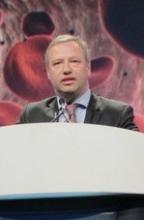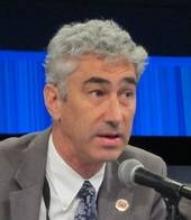CHICAGO – Triaging chest-pain patients with cardiac CT angiography increased direct emergency room discharges and shortened hospital stays, but did not reduce costs, compared with a standard emergency department evaluation, in the prospective, randomized ROMICAT-II trial.
There were no missed cases of acute coronary syndrome with either strategy in ROMICAT II, the Rule Out Myocardial Infarction using Computer Assisted Computed Tomography II trial.
Incorporating cardiac computed tomography angiography (CCTA) early into an emergency department (ED) evaluation strategy improves clinical decision making for ED triage compared to current practice and is safe, principal investigator Dr. Udo Hoffmann said at the annual meeting of the American College of Cardiology.
ROMICAT II evenly randomized 1,000 patients, aged 40-74 years, with suspected acute coronary syndrome to the CCTA-based strategy or standard ED evaluation. Their mean age was 54 years and half had 2-3 major cardiovascular risk factors.
The average time to diagnosis was shortened by 8 hours with CCTA from 18.7 hours with a standard evaluation to 10.4 hours. A diagnosis could not be made in 4% of CT scans.
The average length of stay, the study’s primary end point, was significantly shorter at 23 hours vs. 31 hours with a standard evaluation. This was driven largely by patients without ACS as a final diagnosis, who averaged 17 hours in the hospital with CCTA vs. 27 hours with a standard evaluation, said Dr. Hoffmann, a cardiac radiologist at Massachusetts General Hospital in Boston.
Patients with an ACS diagnosis had similar lengths of stay, averaging 86.3 hours vs. 84 hours, respectively. ROMICAT I reported an 8% prevalence of ACS in acute chest-pain patients at low to intermediate risk of ACS.
"An interesting data point here is that it took about 8 hours to discharge 50% of patients in the CT arm, while it took about 18 hours longer to discharge 50% of patients in the standard-of-care arm," he said.
The number CCTA patients discharged directly from the emergency department was triple that of the standard-evaluation group (46.7% vs. 12.4%), with no missed ACS. At 28 days, major adverse cardiovascular events were similar, reported in two CCTA and five standard-care patients. In all, 13 CCTA patients and 19 standard-care patients returned to the ED, with seven repeat hospitalizations in both groups.
Invited discussant Dr. Matthew Budoff, director of the University of California, Los Angeles BioMed CT Reading Center, observed that similar trends were just reported at the meeting from the American College of Radiology Imaging Network PA 4005 trial and were reported last year from the CT-STAT (Computed Tomography for Systematic Triage of Acute Chest Pain Patients to Treatment trial. (J. Am. Coll. Cardiol. 2011;58:1414-22).
"We’re now garnering significant clinical evidence with three randomized trials that are all very consistent," he said.
Financial Costs
While cost analyses are still awaited from American College of Radiology Imaging Network PA 4005, hospital billing data from a subset of patients in ROMICAT II showed that ED costs with the CCTA strategy were significantly lower, at 19% less per patient at a mean of $2,053 vs. $2,532 with a standard evaluation, Dr. Hoffmann reported. Hospital costs, however, were 50% higher with the CCTA strategy ($1,950 vs. $1,297), driven largely by significantly more diagnostic testing during the index stay and more invasive coronary angiography (12% vs. 8%).
Dr. Hoffmann said Medicare data have shown a doubling in procedures and costs after CCTA. He described the absence of an increase in costs as "a major step forward," but also acknowledged "there’s always room for improvement."
He went on to say that CCTA may become more cost effective as technology evolves and the effectiveness of CT increases and as emergency room experience with CCTA improves. ROMICAT II was conducted at centers without ED CCTA experience, and required training by Dr. Hoffmann and a coauthor was not included in the cost analysis, he acknowledged.
Dr. Michael Crawford, professor of medicine and chief of clinical cardiology at the University of California, San Francisco Medical Center, pointed out that CCTA use in ROMICAT II was very contained since enrollment was limited to patients coming to the emergency room on weekday business hours only.
"So if you expand this to 24/7 coverage, the cost has to go up," he told reporters. "The question of what you save downstream by avoiding further tests remains to be shown in the future."
Radiation Costs
Invited discussant Dr. Elliott Antman expressed concerns about the cost of radiation exposure, noting that there was roughly a threefold increase in the cumulative radiation dose with the CCTA strategy (14.3 5.3 mSv vs. 5.3 mSv), and that chest-pain patients often present to different emergency departments.



